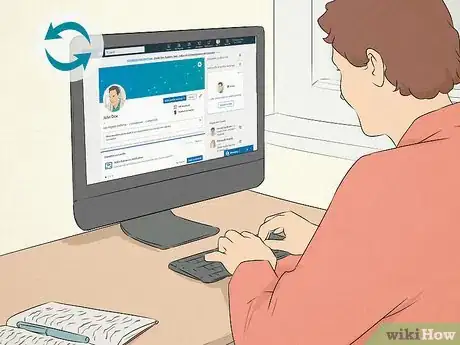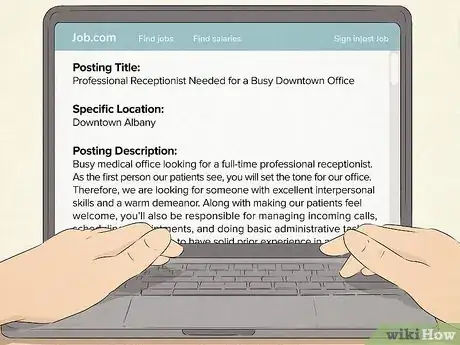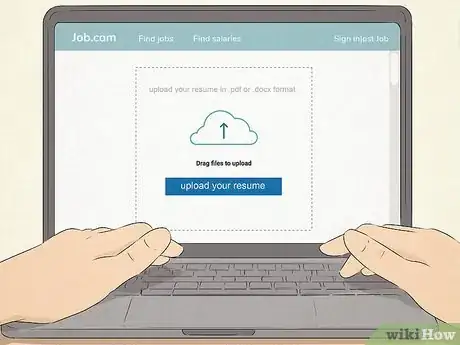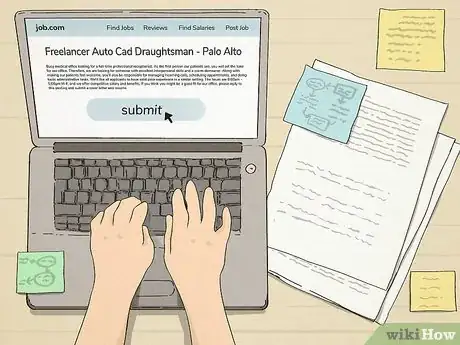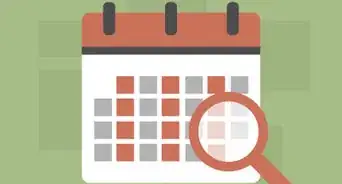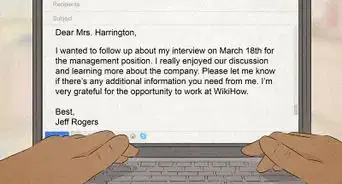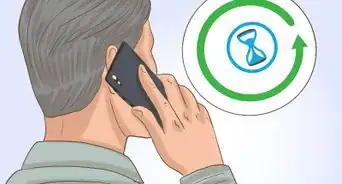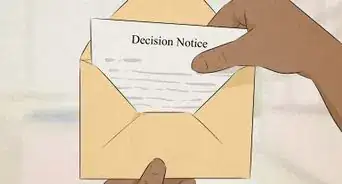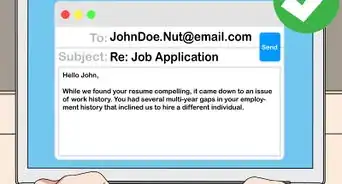This article was co-authored by Adrian Klaphaak, CPCC and by wikiHow staff writer, Danielle Blinka, MA, MPA. Adrian Klaphaak is a career coach and founder of A Path That Fits, a mindfulness-based boutique career and life coaching company in the San Francisco Bay Area. He is also is an accredited Co-Active Professional Coach (CPCC). Klaphaak has used his training with the Coaches Training Institute, Hakomi Somatic Psychology and Internal Family Systems Therapy (IFS) to help thousands of people build successful careers and live more purposeful lives.
There are 12 references cited in this article, which can be found at the bottom of the page.
wikiHow marks an article as reader-approved once it receives enough positive feedback. In this case, 86% of readers who voted found the article helpful, earning it our reader-approved status.
This article has been viewed 1,405,441 times.
Applying for jobs can be a really stressful process, so you likely want to do anything you can to increase your chances of success. Fortunately, there are tips and techniques you can use to make your resume, cover letter, and application stand out from the other candidates. While you might have to send out several applications before you find the right job for you, try not to lose hope because new jobs are popping up every day. With your hard work and dedication, you can get an employer's attention and secure an exciting job opportunity.
Steps
Creating Your Application Materials
-
1Search for jobs that fit your strengths and skill set. Most organizations post available jobs online. Visit employment websites like LinkedIn, Indeed, and Monster to find job listings. Type in keywords for the type of job you want to see what’s available. Additionally, check if companies in your industry have job openings listed on their website. You might also check the classifieds in your area.[1]
- During the COVID-19 pandemic, you might focus your search on industries that are essential or that are part of the pandemic response. For instance, warehouses, package delivery services, grocery stores, and healthcare providers may be hiring. Similarly, you might be able to get a job as a contact tracer, phone customer service representative, or online educator.[2]
-
2Research the company before you apply. Do an online search to find the company’s website, social media pages, and any news articles that are out there. Read about their company mission, current projects, and available positions. Take notes so you’ll be able to include this information in your resume and cover letter.[3]
- If the interviewer or hiring manager is listed, look up their LinkedIn profile and social media pages to learn more about them. Use this information to help you relate to them so you might have an edge over your competition. For instance, you might find that you went to the same school or have the same degree, and you could highlight that in your cover letter.
- Pay attention to their current goals and company needs. For instance, during the COVID-19 pandemic, some employers have different needs than usual. Incorporate these things into your application materials.[4]
Advertisement -
3Write a resume that highlights your education, skills, and experience. After you write your resume, get someone you trust to proofread it to make sure you don’t have any errors and you didn’t leave anything out. Include the following information on your resume:[5]
- Your name, contact information, and email address at the top.
- Your educational background or training you’ve done.
- Your work history, including your responsibilities and achievements.
- Special knowledge and skills.
-
4Tailor your resume to each job description. You might be tempted to use the same resume for each job application, but you’re more likely to get an interview if you adjust your resume for each individual job. Review the job description and incorporate the keywords into your resume. Focus mostly on the skills and education you have that are directly related to the job you're currently applying for.[6]
- During the COVID-19 outbreak, highlight your remote work and technical skills because they're currently in demand for some jobs.[7]
- Use active verbs to describe the work you’ve done at prior jobs or volunteer work. For instance, use verbs like "designed," "implemented," "innovated," or "analyzed."
-
5Ask 3 people to be references for you. Many employers ask you to provide professional references who can speak to your job performance. Choose people who’ve worked closely with you in the past, such as a former supervisor or coworker. Talk to the people you want to use as references to make sure they’re okay with you providing their information to the employer. Then, confirm their contact information so you can include it on your application.
- Get each reference’s full name, phone number, email address, current title, and current employer.
-
6Write a cover letter if one is requested. A cover letter is your chance to tell the employer exactly why you want the job and why they should hire you over the other candidates. Use an enthusiastic tone in your cover letter to convey your excitement for the job. Additionally, tailor your cover letter to the person who is interviewing candidates if possible so they know you pay attention to details. You might include the following in your letter:[8]
- Why you’re interested in the position.
- How you’ll be an asset to the company or organization.
- Why you’re the best person for the job.
- What you hope to learn from the job.
-
7Update your LinkedIn profile if you have one. You don’t need a LinkedIn profile to get a job, but it may help employers get more information about you. Make sure all of the information on your profile is current and accurate. Use your profile to include information about you that doesn’t fit on your resume due to limited space.[9]
- For instance, you might include more information about projects you’ve worked on or volunteer positions you’ve held that just don’t fit in the space you have on your resume.
- Add keywords related to remote working and technology skills if you’re applying for a job during the COVID-19 pandemic.[10]
- Virtual networking is becoming a popular way to make job contacts during the COVID-19 outbreak. Polish your profile and try to make connections with people in your industry.[11]
-
8Make sure your online presence is squeaky clean. Employers and recruiters often scour the internet looking for you, and any negativity they see may make them eliminate you as a candidate for the job. Review the public content on all of your social media profiles. Change your privacy settings to hide anything you don’t want seen. If necessary, delete posts that are outdated and don’t represent who you are now.[12]
- For instance, you might hide or delete photos of you during nights out on the town. Similarly, you might delete old posts where you complained about a job or joked around at work.
- Consider asking a few friends to review your profiles and tell you if they spot anything that might turn off a potential employer.
Submitting an Application Online
-
1Read the job description thoroughly to make sure you’re qualified. Review the job description at least twice to make sure you understand what the employer is looking for. Highlight specific skills and educational qualifications you have. Additionally, look for the keywords the employer might be expecting to see on a resume.[13]
- For instance, keywords might include things like “remote work,” “self-starter,” “innovative,” or “team player.” Skills you might notice could include “proficiency in Zoom” or “ability to work with others.”
-
2Check the application requirements with the employer if you’re using a jobs site. While employment websites are an excellent resource for helping you find a job, sometimes the job posting on a jobs site may differ from the employer’s posting. When this happens, you may accidentally submit the wrong materials or leave out important information that can sabotage your chances of getting the job. Before you submit your application, review the original job posting on the employer’s website to make sure you follow the instructions exactly.[14]
- For instance, the employer’s website may say to send your cover letter and resume directly to the person who’s interviewing the candidates. Similarly, they may ask you to address specific things on your resume, like your previous salary.
-
3Fill out every field on the application. You may get frustrated if the application asks you to re-enter information you’ve already provided, like the contents of your resume. However, entering this information on the application itself makes it easier for the employment software to scan your information to see if you’re a good fit for the job. Additionally, it’s generally easier for the interviewer to read. Make sure you give full and accurate answers for each question to give yourself the best chance at getting the job.[15]
- Consider typing your answers in a word processing document so you can easily proofread it. Then, copy and paste it into the application.
- If you want the employer to know something about you, such as past job responsibilities that relate to the position you want, include it in the relevant application fields. Don’t assume they’ll see it on your resume.
- Don’t use the auto-fill feature on the application because you might accidentally enter the wrong information in the box.
-
4Import your resume and cover letter, if requested. Many employers ask for a resume and cover letter, even if you’re submitting an application, as well. Look for a button on the website where you’re applying that say’s “import” or “upload.” Click on this button and select the document files you want to send the employer. Check that your documents uploaded properly before you submit your application.[16]
- Make sure you pick the right document for this job. It might help to clearly label your resume and cover letter so you know which one is for which job.
-
5Review your application to make sure it’s free of errors. Mistakes on your application may make the employer think you don’t pay attention to details, so it might hurt your chances of getting the job. Read over all of your responses to verify that you didn’t make any errors. Correct any mistakes you made and add additional details if you think some of your answers are too vague.[17]
- Double check for typos, misspellings, and grammatical errors. Some employers might ignore your application if they spot these types of mistakes because they likely have a lot of applicants to sort through.
-
6Submit your application through the website if you’re using one. When you’re ready to send in your application, look for a button that says “submit.” It will likely be on the bottom of the screen. Click this button to send your application and uploaded materials to the employer.[18]
- After you hit “submit,” you likely won’t be able to correct your application, resume, or cover letter. Make sure everything is perfect before you send in your application.
-
7Email your materials to the employer if you’re applying directly. Some employers may prefer that you send your resume and cover letter directly to the hiring manager or human resources department. Enter the email address into the email form and check that it’s right. Create a subject line that fits the instructions in the job posting. Then, attach your resume and cover letter. Type out a short message to the recipient telling them that you’re interested in the job and have attached your materials.[19]
- Your subject line might be, “Applicant for IT Position,” “Resume and Cover Letter for Gallery Attendant,” or “In Response to Job Posting.”
- Your short message might say, “I’m excited to apply for the position of Gallery Attendant with your museum. As a museum member, I’ve spent many hours in the galleries, so I’ll be a great fit for the position. Please find attached my resume and cover letter, which will show you how I’ll be an asset for your organization.”
Applying for a Job In-Person
-
1Dress like you’re going to a job interview. Your first impression with a potential employer is very important, so wear professional attire, no matter what type of job you want. This shows the employer that you’re taking your job hunt seriously.[20]
- You might wear a button-up shirt, slacks or a skirt, and dress shoes. To really enhance the professionalism of your outfit, put on a blazer or cardigan over your ensemble.
- If you’re applying for a job in retail or restaurant work, you might get a quick first interview on the spot.
-
2Ask to talk to the hiring manager. Smile and greet the employee who first makes contact with you. Then, say that you’re looking for a job and would like to talk to the hiring manager. Wait patiently for the person to come meet with you.[21]
- Say something like, “Hi, I’m here to ask about a job. Is your hiring manager available for a quick conversation?”
- If they’re unavailable, ask when is a good time to return. You might say, “When would be a good time for me to come back?”
- If you see that the business is super busy, it’s best to come back at a later time. You won’t make a good first impression if you put your needs in front of the employees and customers.
-
3Tell the hiring manager you’re interested in applying for open positions. Take this moment to quickly explain why you want to work there. Express your interest in the company, then ask if there are open positions you can apply for. If so, ask if you can fill out an application.[22]
- You could say, “Hi, I’m Taylor Evans. I’m a regular customer here and am very knowledgeable about your products, so I think I’d be an asset to your business. I was wondering if you have any unfilled positions.”
- Keep in mind that some organizations don’t have applications. In that case, they may just take your resume.
-
4Hand the company representative a copy of your resume. It’s always a good idea to bring your resume with you because it shows you’re dedicated to getting the job. Give your resume to the hiring manager to look at when they have time. If they review it immediately, answer any questions they might have for you.[23]
- Only bring in 1 or 2 copies of your resume. Otherwise, the hiring manager may think you’re applying everywhere. Even if that’s the case, you want them to think that you’re specifically interested in their workplace.
- Don’t expect the hiring manager to read it right away, as they may be really busy. Keep a positive attitude even if they tuck it away.
-
5Fill out a job application if the company has one. The hiring manager may give you a paper application, though they might direct you to fill out an application online. Provide accurate answers to all of the boxes, then double check that you haven’t made any mistakes. If it’s a paper application, smile as you hand it back to them to show you’re excited about the job.[24]
- You might hand it to them and say, “Thank you so much for this opportunity!”
-
6Thank the employees for their time before you leave. Tell each person that you talked to that you’re grateful for the time they spent talking to you. Be sure to smile as you do this so your thanks seems genuine.[25]
- Say something like, “Thank you so much for taking the time to talk to me,” or “Thank you for all of your help.”
Following up on Your Application
-
1Contact the employer a week after submitting your application. Checking on the status of your application shows your interest in the position and ensures that your application materials have made it to the appropriate person. Call the employer, send the employer an email, or message the interviewer on LinkedIn to follow-up. Ask if they’re received your application and inquire about the hiring process.[26]
- Keep track of when you applied for each job to make sure you remember to follow-up.
- During the COVID-19 pandemic, some hiring managers and human resources departments are overwhelmed and may be working from home. Be mindful of this when you contact them. You might wait a few extra days before contacting them. Additionally, keep your message short and friendly.[27]
-
2Use a friendly, positive tone when talking to the employer. You’re likely really anxious for an answer, but you might make a bad impression if you sound nervous or demanding. Be kind to every employee you talk to at the organization. Ask basic questions and accept whatever answer you receive.[28]
- For instance, don’t make demanding comments like, “I haven’t been contacted yet,” or “How long will it take for you to go through the applications?” Instead, say something like, “Have any decisions been made,” or “Can you give me a little information about the hiring time frame?”
-
3Tell them you understand COVID-19 may affect their needs and timeline. Many employers are adjusting their workforce due to changes in the economy. Additionally, employees may be working remotely and might be handling extra responsibilities. Explain that you understand what they’re dealing with right now and are flexible to fit their needs. Doing so shows them you’re a team player and are willing to adjust as needed if you’re hired.
- You might say, “I recognize that the pandemic may affect your hiring needs, but are you still hiring for this position?” or “I know the hiring timeline might shift because of the pandemic, but do you have an overview of what I can expect?”
Sample Email, Resume, and Cover Letter
Expert Q&A
-
QuestionHow can I be more confident if I don't have any experience in a role?
 Meredith Walters, MBAMeredith Walters is a Certified Career Coach who helps people develop the skills they need to find meaningful, fulfilling work. Meredith has over eight years of career and life coaching experience, including conducting training at Emory University's Goizueta School of Business and the US Peace Corps. She is a former Member of the Board of Directors of ICF-Georgia. She earned her coaching credentials from New Ventures West and a Master of Business Administration from the University of San Francisco.
Meredith Walters, MBAMeredith Walters is a Certified Career Coach who helps people develop the skills they need to find meaningful, fulfilling work. Meredith has over eight years of career and life coaching experience, including conducting training at Emory University's Goizueta School of Business and the US Peace Corps. She is a former Member of the Board of Directors of ICF-Georgia. She earned her coaching credentials from New Ventures West and a Master of Business Administration from the University of San Francisco.
Certified Career Coach You may not have experience in a specific job, but you probably have strengths related to the required skills for that job. For example, you may have never performed a stand-up comedy skit, but you may have a good sense of humor, the ability to tell a joke, or good writing skills. If you focus on your strengths instead of your experience, you'll have a much easier time building your confidence.
You may not have experience in a specific job, but you probably have strengths related to the required skills for that job. For example, you may have never performed a stand-up comedy skit, but you may have a good sense of humor, the ability to tell a joke, or good writing skills. If you focus on your strengths instead of your experience, you'll have a much easier time building your confidence. -
QuestionDo I still have to dress formally if I'm being interviewed to work at a fast food place?
 Community AnswerYes, you should absolutely dress formally when interviewing for jobs, regardless of what type of work you are looking to be hired to do. First impressions are important, so make it count!
Community AnswerYes, you should absolutely dress formally when interviewing for jobs, regardless of what type of work you are looking to be hired to do. First impressions are important, so make it count! -
QuestionDo I have to disclose the reason for leaving my previous employer?
 Community AnswerOnly if it's relevant or for a good reason. You don't want to make a bad impression by saying that you left them for a bad reason.
Community AnswerOnly if it's relevant or for a good reason. You don't want to make a bad impression by saying that you left them for a bad reason.
References
- ↑ https://www.forbes.com/sites/nextavenue/2016/07/28/8-dos-and-donts-when-you-apply-for-a-job-online/#78304d1d1b75
- ↑ https://www.cnbc.com/2020/04/07/how-to-get-a-company-to-hire-you-during-the-coronavirus-outbreak.html
- ↑ https://www.forbes.com/sites/nextavenue/2016/07/28/8-dos-and-donts-when-you-apply-for-a-job-online/#78304d1d1b75
- ↑ https://www.cnbc.com/2020/04/07/how-to-get-a-company-to-hire-you-during-the-coronavirus-outbreak.html
- ↑ https://www.youthcentral.vic.gov.au/jobs-and-careers/applying-for-a-job/what-is-a-resume/how-to-write-a-resume
- ↑ https://money.usnews.com/money/blogs/outside-voices-careers/2012/07/11/the-9-best-tips-for-submitting-an-online-job-application
- ↑ https://attheu.utah.edu/facultystaff/top-tips-for-job-searching-during-covid-19/
- ↑ https://www.youthcentral.vic.gov.au/jobs-and-careers/applying-for-a-job/what-is-a-cover-letter/how-to-write-a-cover-letter
- ↑ https://www.forbes.com/sites/nextavenue/2016/07/28/8-dos-and-donts-when-you-apply-for-a-job-online/#78304d1d1b75
- ↑ https://attheu.utah.edu/facultystaff/top-tips-for-job-searching-during-covid-19/
- ↑ https://attheu.utah.edu/facultystaff/top-tips-for-job-searching-during-covid-19/
- ↑ https://money.usnews.com/money/blogs/outside-voices-careers/2012/07/11/the-9-best-tips-for-submitting-an-online-job-application
- ↑ https://money.usnews.com/money/blogs/outside-voices-careers/2012/07/11/the-9-best-tips-for-submitting-an-online-job-application
- ↑ https://www.forbes.com/sites/nextavenue/2016/07/28/8-dos-and-donts-when-you-apply-for-a-job-online/#f1140a71b753
- ↑ https://www.forbes.com/sites/nextavenue/2016/07/28/8-dos-and-donts-when-you-apply-for-a-job-online/#f1140a71b753
- ↑ https://money.usnews.com/money/blogs/outside-voices-careers/2012/07/11/the-9-best-tips-for-submitting-an-online-job-application
- ↑ https://money.usnews.com/money/blogs/outside-voices-careers/2012/07/11/the-9-best-tips-for-submitting-an-online-job-application
- ↑ https://money.usnews.com/money/blogs/outside-voices-careers/2012/07/11/the-9-best-tips-for-submitting-an-online-job-application
- ↑ https://www.forbes.com/sites/nextavenue/2016/07/28/8-dos-and-donts-when-you-apply-for-a-job-online/#f1140a71b753
- ↑ https://studentaffairs.psu.edu/career/resources/interviewing/dress
- ↑ https://careertrend.com/what-to-say-when-you-walk-in-to-apply-for-a-job-13657120.html
- ↑ https://careertrend.com/what-to-say-when-you-walk-in-to-apply-for-a-job-13657120.html
- ↑ https://www.forbes.com/sites/ashleystahl/2017/07/13/should-you-apply-for-jobs-online-or-in-person-an-analysis/#c88a9587e293
- ↑ https://careertrend.com/what-to-say-when-you-walk-in-to-apply-for-a-job-13657120.html
- ↑ https://www.forbes.com/sites/ashleystahl/2017/07/13/should-you-apply-for-jobs-online-or-in-person-an-analysis/#c88a9587e293
- ↑ https://money.usnews.com/money/blogs/outside-voices-careers/articles/how-to-follow-up-on-a-job-application
- ↑ https://www.cnbc.com/2020/04/07/how-to-get-a-company-to-hire-you-during-the-coronavirus-outbreak.html
- ↑ https://money.usnews.com/money/blogs/outside-voices-careers/articles/how-to-follow-up-on-a-job-application
- ↑ https://attheu.utah.edu/facultystaff/top-tips-for-job-searching-during-covid-19/
- ↑ https://www.cnbc.com/2020/04/07/how-to-get-a-company-to-hire-you-during-the-coronavirus-outbreak.html
- ↑ https://www.rutgers.edu/news/four-tips-interviewing-landing-new-job-during-covid-19
About This Article
Before applying for a job, look up what the requirements are and make sure that you meet them. When you’re ready to apply, create a resume that includes your contact info, work history, education, and relevant skills. Then, write a cover letter introducing yourself and explaining what you can bring to the organization. Ask at least 3 professional or personal friends to be your references, and have their contact information on hand in case your employer requests them. For tips on how to nail a job interview, read on!






